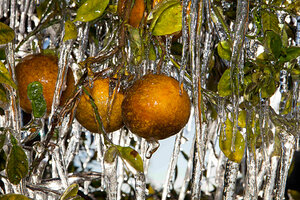Cold weather ends, but has damage to Florida oranges been done?
Cold weather in the South was finally breaking Tuesday, leaving Florida growers to count the cost to their orange crop, which provides the US with 75 percent of its orange juice.

Icicles hang from an orange tree after it was sprayed with water throughout the night in Plant City, Florida, on January 6.
Scott Audette/Reuters
Fort Lauderdale, Fla.
Monday night provided one last reminder of a record-setting cold snap that left citrus trees in Florida encased in icicles and prompted fears among growers of widespread damage to the crop.
But even as the orange groves thawed Tuesday as the cold weather broke, the outlook remained distinctly chilly for the industry's growers and packers, with some analysts suggesting that 7.5 percent of this year's crop could be lost to the big freeze.
"We haven't had anything like this in a while," says Kristen Gunter of the Florida Citrus Processors Association. "They were cutting ice in some fruit in some groves in the central Florida ridge. I'm not suspicious of the people who are putting these numbers out."
The cold snap's precise cost to the $9.3 billion industry, which produces more than 75 percent of orange juice sold in the US, cannot be calculated accurately for several weeks, Ms. Gunter says, because it takes that long for ice damage to manifest itself in the trees. Growers might see only minor leaf burn or twig damage now, but discover later that their trees are a total loss.
"The truth is nobody today really knows what the impact will be," she says.
How much damage?
Temperatures across northern Florida orchards dropped into the mid-20s or lower on Saturday and Sunday nights. In central Florida, they hovered below freezing. For fruit damage to set in, temperatures must drop to 28 degrees F for four hours or more. Anything below that for longer periods usually kills a tree.
"The reports we are getting tell us there is frozen fruit, as well as twig and leaf damage out there now," says Michael Sparks, executive vice president of Florida Citrus Mutual, a trade body representing almost 8,000 growers.
But, he adds, "all the information is anecdotal and varies from grove to grove, so we won't be able to come out with a definitive answer until the [US Department of Agriculture's] ... monthly crop forecast, probably in February."
Orange juice prices rise
The impact on orange juice prices in the shops, however, might come earlier. Prices were already rising when the USDA estimated in December that Florida's crop this season would total 135 million boxes, a 17 percent reduction from the previous year.
Tuesday, the department will issue its January estimate, which many observers expect to show a further reduction, even though it will not incorporate the cold snap.
Tampa-based Liberty Trading Group, a brokerage firm that analyzes the citrus industry, said Monday that anything between 5 million and 10 million boxes could be lost to the cold snap.
But orange juice futures on the US InterContinental Exchange dropped almost 20 cents, which reflects optimism that the damage might not be as bad as first feared.
"Prices come down to a number of factors, not just how many boxes of fruit are on a tree," says Gunter of the Florida Citrus Processors Association. "Our growers have had a tough time: the hurricanes of 2004, pests threatening trees, and now this freeze."
-----
Follow us on Twitter.
